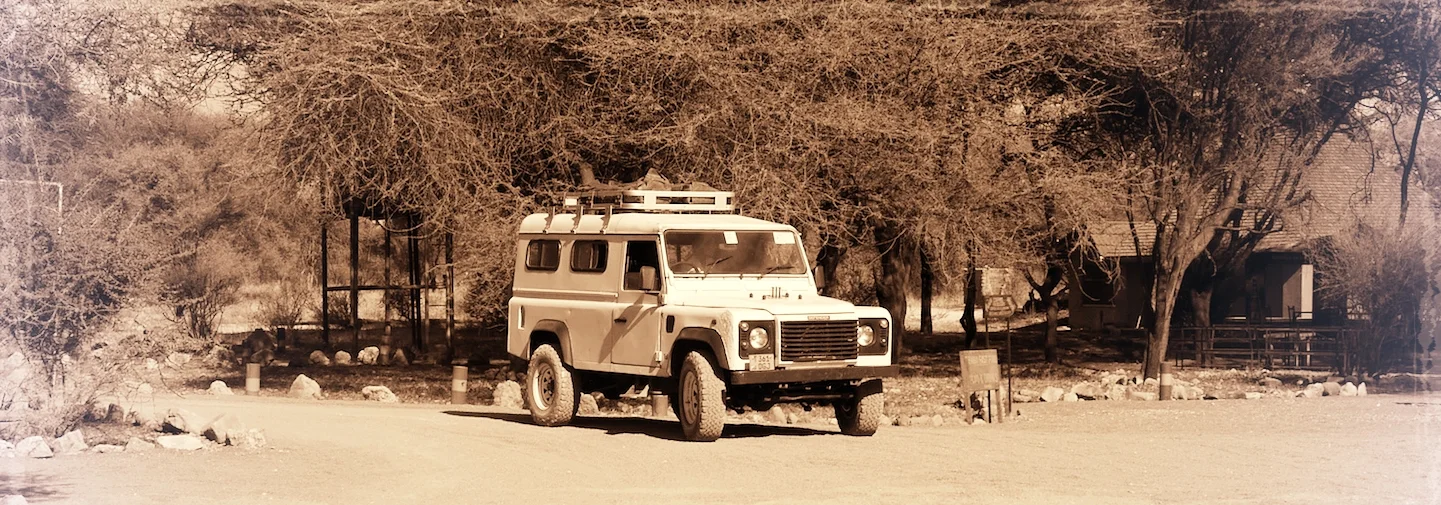The term safar off the Arabic tongue communicates the idea of a "journey" or "voyage." As it cartwheels into English ears via Swahili, it suggests not just any walkabout, but one taken specifically on the oldest continent with the goal of experiencing life in the bush. Little effort is required to conjure up the image of the sporting man wearing khakis and pith helmet, accessorized by a lever-action big-bore rifle ("bring enough gun" they told him wryly). Such a person marches in the company of porters through a sepia colored landscape by day and enjoys outdoor dining with tablecloth, smokes, and tall stories by night. (If your imagination needs a jumpstart, curl up by the fire with Papa's Green Hills of Africa or Dineson's Out of Africa. In a matter of minutes you will hear the lions of the night, guaranteed.)
From an African safari in the 1920s. Image from here.
I was thrilled by the thought of concluding our time in Tanzania with a safari. The knees were still wobbly from the stresses of Kilimanjaro, but Tommy, Jason, and I found the energy to pitch our duffels and then ourselves into Saidi's knobby-tyred truck. The cruiser growled in response. Saidi found the gear and we lurched forward. We lacked gun and pith helmet. We aimed to encounter the wildness of East Africa, God-willing, in a more bloodless way.
Image courtesy of Google Earth.
The truck nosed west. Saidi located another gear. Soon, the chaos of Arusha disappeared in the rear-view mirror.
The stiff suspension made for a less-than-comfortable ride, but we knew that the clearance would be appreciated later. Conversation was sporadic. Saidi was a pleasant-faced chap who dispensed knowledge thriftily. His knowledge of the steppe did not flow out as a current, but rather, came out in drips. We dozed.
Other than flashes of green, the surrounding plain was brittle brown. I pointed out this obvious truth and wondered aloud if we would be disadvantaged by it (where does one begin looking for wildlife under this huge African sky?). Saidi said this actually worked in our favor. "We go to the water. That is where the animals are."
We threw our gear and ourselves into the truck.
From the open window, I watched Maasai herdsmen demonstrate the truth of Saidi's words. This was their country and these were their waterholes. I leaned out with my camera and tasted the dust. Herds of goats and zebu-cattle rimmed the brown pools. Their lean handlers stood by, sticks in hand.
A busy waterhole west of Arusha.
We continued rolling through this vast and open space. We passed trucks, bicycles, cows, motorcycles, walkers, sitters, squatters, and several vehicles like our own, headed for backcountry. A posted sign directed travelers to the Serengeti. It seemed to be a popular route. We went straight.
Passing through a village. The Maasai are tall and lean people who wear bright dress. They are semi-nomadic pastoralists who carry cell phones, seemingly caught between the past and the present.
Our goal was Tarangire National Park in the region of Lake Manyara. It is touted as a hidden gem in northern Tanzania: one of the largest, but least visited of the Tanzania National Parks (TANAPA) family. The Tarangire River, which bequeaths its name to the region, intersects a main migration route. In the wet season, life disperses across the Great Rift Valley; in the dry season it concentrates in places like this.
We passed an invisible line. Saidi told us to be on the alert. His words were still hanging in the air when a giraffe stepped out from between some acacia trees to our right. "Look!" I cried, as if I had never seen a giraffe in my life. I had, actually, but had never seen one ambling near the road like a Kentucky deer. It made me wonder if giraffes ever dart or if cars ever hit them? Wouldn't that make a mess?
Buoyed by this sighting, we checked the settings on our cameras and doubled down on the watch.
Boys and herd on the way to (or from?) the waterhole.






